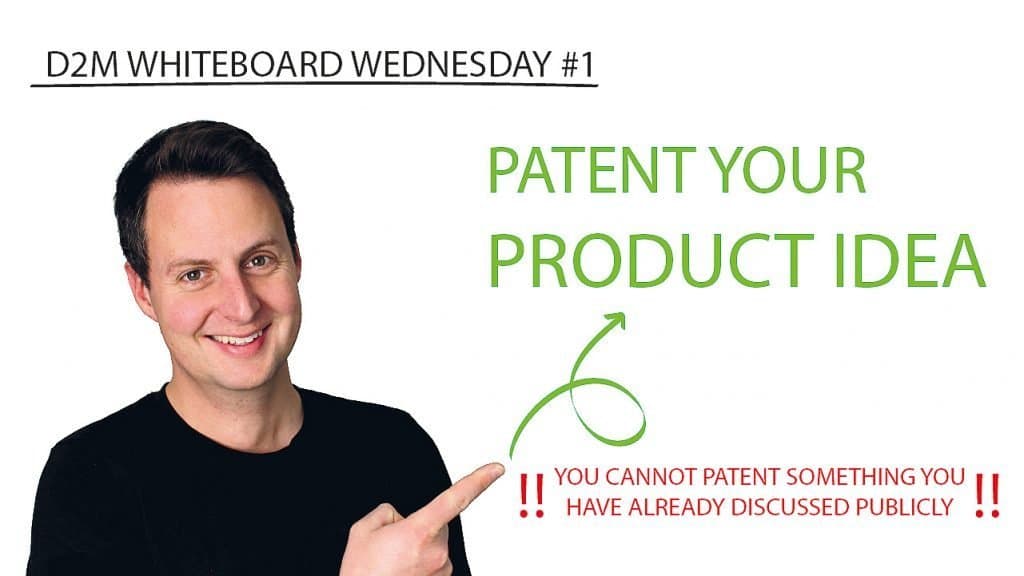Watch this video to understand how to patent an idea. The video explains in detail the process involved when patenting an idea, useful tips and an estimate guide on how much this will cost.
Full transcript on this patent video can be found below.
Here are the patent questions answered in this video:
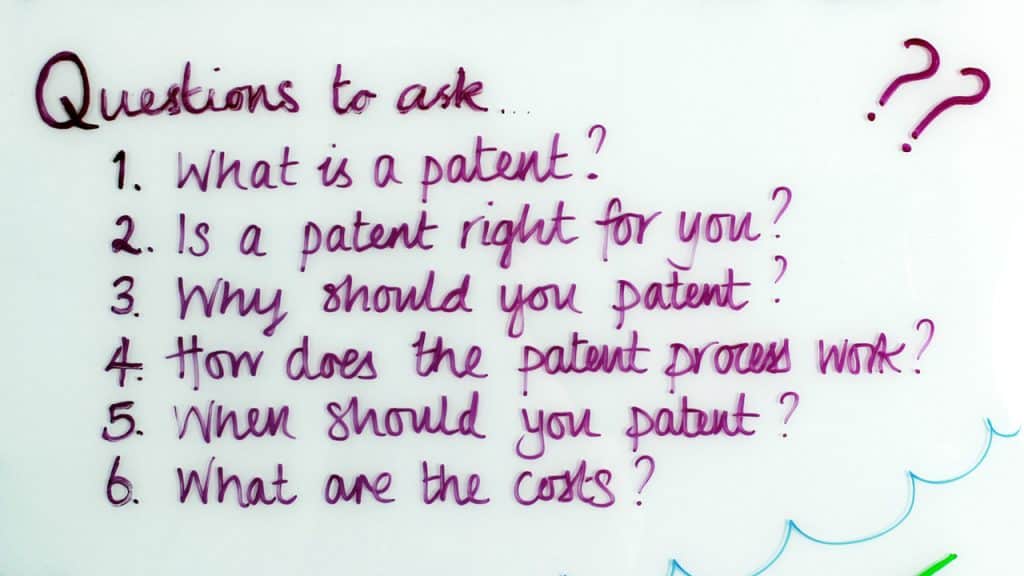
Whiteboard Wednesday – Beginners Guide to Patenting
So this video is all about how to patent an idea maybe you’ve had a new idea for a new product but you don’t know where to start with protecting it. Maybe you want to know more about the patent process before you talk to a patent attorney because you don’t want to look stupid or maybe you’re just or maybe you’re just really worried that patents are going to cost you thousands of pounds and you can’t afford that. Well, good news patenting doesn’t need to cost you loads of money and if you keep watching to the end of the video you’ll learn how to keep your costs minimized and how you can afford to not only patent your idea but how you can also afford to enforce that patent should anyone copy your idea as well. So keep watching so this is what we’re going to cover in this video we’re going to cover:
• what is a patent is a patent right for you
• why should I patent,
• how does the patent process work
• when should you patent the idea and
• what are the costs
So that’s what we’re going to cover.
I’m Phil Staunton, I’m managing director of D2M Innovation and I’ve worked with hundreds of people over the last nearly 20 years on developing and protecting ideas. I’ve also got my own patent on a product which I’m going to use as a case study in this video, so I know the process from both sides and best of all I’m not a patent attorney which means I don’t speak Latin and hopefully I should be able to explain things in simple easy to understand ways so what is a patent.
Well a patent is a way of protecting a new idea for doing something it gives the inventor exclusive rights to use that new way of doing something. Often for 20 years if the inventor continues to pay the annual renewal fees on the patents now it doesn’t protect the look of something so if you’ve got a new design, of stool and it functions exactly the same way but it just looks very different then that is something you protect by a registered design. Maybe you’ve got a brand a tagline and a new logo or that’s something you protect with a trademark patents are reserved for functional ways of technically solving problems and there are three things that that must be in order to get a patent it must be:
• useful and capable of being made or
• used it must be inventive and non-obvious to someone skilled in that area
• and finally it must be unique it can’t have been done already.
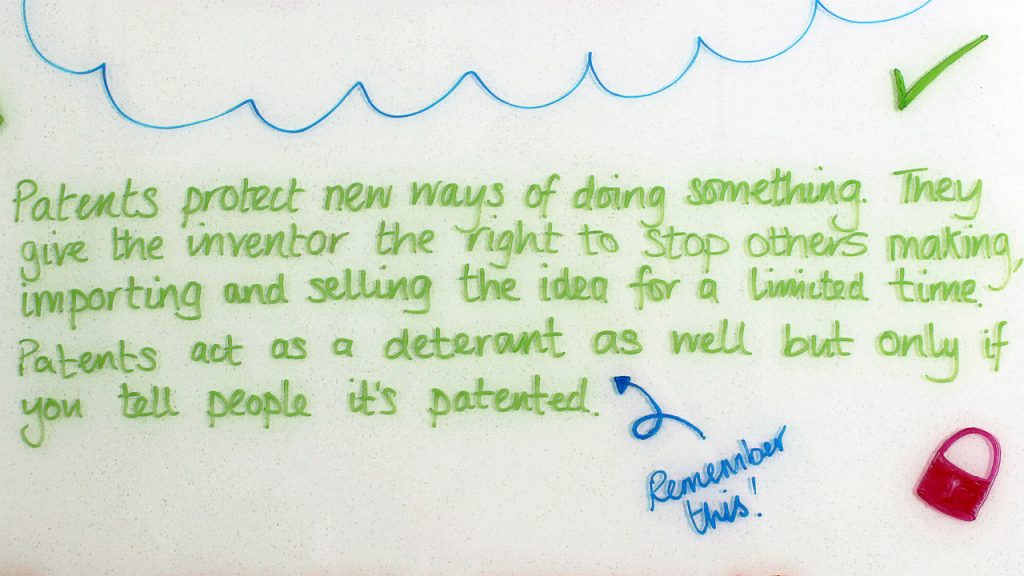
So there are three key requirements to get a patent on your new idea now in my experience working on patented products for a long time. Now most patents are small incremental improvements on part of an existing product I’m going to use my own products that I’ve got a patent on to explain that and bring that to life.
This is a push chair carry cot and I’ve got a patent on this particular carry cot I haven’t got a patent on the idea of a carry cot tool because that’s been done before and I haven’t got a patent on the way that the hood folds down or the way that collapses or the way it clicks into a push chair because all that’s already known and has already been done, but what we did come up with is a new ventilation system with flaps both front and back so then when you open those on a hot day and you push the push chair along you get a through flow of air over the baby and you cool the baby down now that hasn’t been done before, and it is useful and therefore I was able to patent that system of opening flaps to allow that and that gives you a good example of what most patents are like.
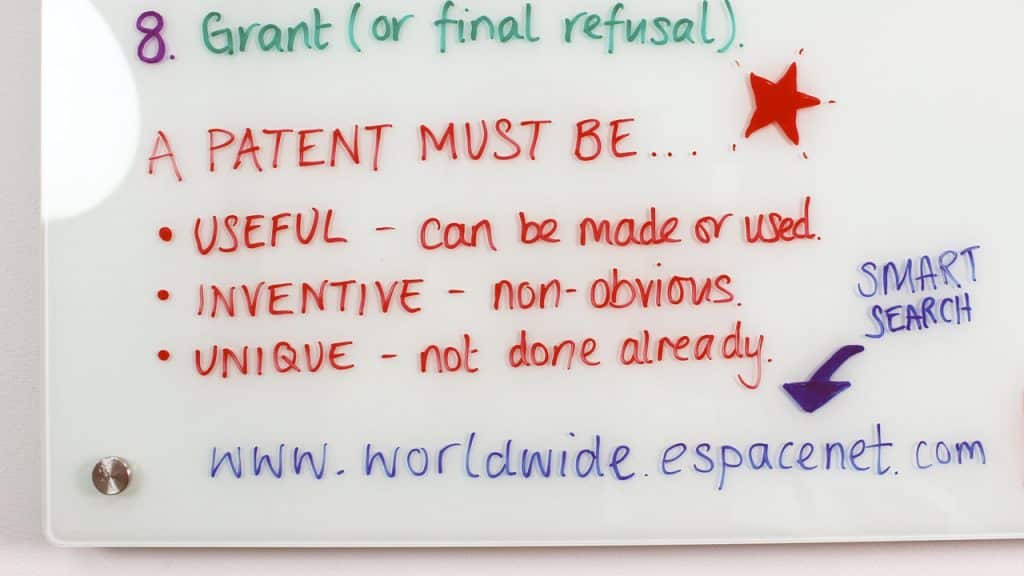
So why patent an idea at all?
Well, if you’re going to develop and prototype and manufacture and launch your own product it’s going to cost you a lot of money time and effort and what you don’t want is to launch that and then find another big company who’s already established in the market with a much larger marketing budget copies your idea and sells a lot more than you do just because they can get it out there just because they can get it out there faster, you’ll also find that investors will often ask about patents and Ip protection because they’re not about to invest a lot of their hard earned money just to find another company rips off the idea after launch. So there’s some good reasons there to get a patent and copycat products happens a lot more often than you think let me give you an example of a product that we’ve designed.
So the RIUT rucksack we designed this back in 2012 along with our client and it’s got zips here against the back so it’s a lot harder for anyone to steal anything out of it which is a great idea but the problem was six months after launch we found products like this on the market as you see zips that mean that it’s against your back and this was one of several copycat products that came onto the market really soon after our client launched their Kickstarter campaign for their product now maybe all those other companies didn’t actually copy the product maybe they came up with the idea independently but that’s one of the points if our client had patented that concept it wouldn’t have mattered if they come up with it independently or not anything that was done afterwards she would have been able to stop because her patent would have given her the exclusive rights to that idea now in this case that hasn’t actually made a huge difference so our client’s done really well anyway and she’s selling loads of different rucksacks across her whole range but that’s one of the main lessons you know just because you’ve got a patent, doesn’t mean you’re going to make loads profit and selling really well and then it gets copied by other people you’ll lose some of that profit and a patent can help stop that.
So, you can find out about that so let’s now look at how the patent process works and basically, we can see it here. So, step one in terms of preparing your patent application you’re going to need to get your drawings together and the claims and the description and all the wording around your patent draft and to get your patent that needs to be enough information that someone who is skilled in that area can build your idea from the details in your pan application often the best way of achieving that is to get a charter patent attorney to do it for you. You can do it yourself but only one in 20 people who does their own patent application ever gets through to grant those are the patent office’s own numbers on that so as you can see it’s quite complicated is not easy and therefore often it is just worth paying a professional to do it for you once you’ve prepared your plan application the next step is filing with the UK intellectual property office and that is the only place that you can file a patent in the UK and again if you’ve commissioned a chartered patent attorney their fees will probably include them filing it and that can be filed online so it gets done very quickly the patent office will then do a patent search for you and you’ll need to review that search report and take a decision that you can anticipate the results that are going to come back and your patent attorney can use the results in that patent search in their drafting to try and avoid infringing other people’s patents and give you a better chance therefore getting through to grant quicker now in about 12 months you’re going to have to consider whether you want to file what’s called a pct.
Now that is an international patent application it’s a holding application that basically will ensure that you can get a patent in something like 147 countries worldwide, so it’s quite a good way to go most of our clients end up doing that application. but basically, you’ve got to decide that 12 months in and that’s part of the process at 18 months your patent will be published and then fairly shortly after that you’ll need to request your substantive examination and this really is where a patent examiner at the patent office will examine your patent in some detail and start to say what you can and can’t get through to grant now that process of them going through it all and you have to respond to that can take up to two or three years as part of that process or it can be very smooth because actually what you’re claiming is unique it is different
it is non-obvious and therefore it can go through quite quickly and obviously if your attorney’s involved in that process then you actually are racking up costs quite rapidly during that process and then finally once you’ve persuaded the patent office examiner that you should get a patent then it goes through to grant now don’t be put off by the fact that can take up to four years because while that process is going on you can still legally use the phrase patent pending and that means that you can use it on your packaging or on your product descriptions or even on the product itself as a deterrent to put people off copying because basically if something’s patent pending if it then does go through to grant you can claim damages from that person who’s copied your idea and that will put people off the clients who really use that phrase they get copied about 50 less than people who don’t you can imagine can’t you if you’re in the market um of getting products off the shelves new products have launched and are successful sending them out to factories.
Now it’s worth saying at this point that you can actually do a patent search yourself you can use this website here and I would suggest using the smart search option on that website and that can give you an initial idea of what’s already out there what’s already been protected before you pay for a professional search or before you go ahead with your patent application and pay for the patent office to do their search and this is often quite a quick way of getting a general understanding of whether your patent is likely to be something that can go through to grant for no cost at all.
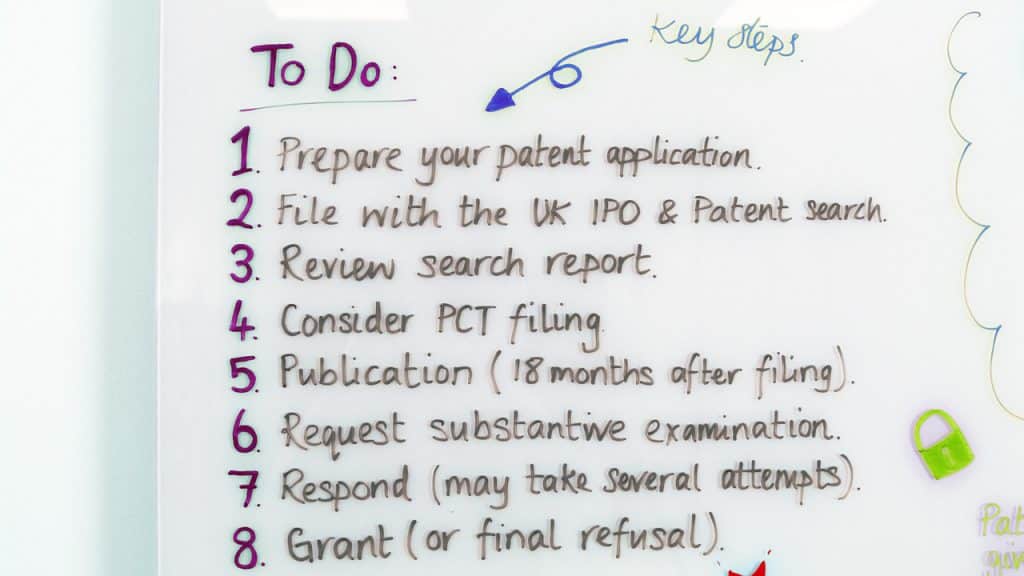
When you should patent your idea?
Basically I get lots of people coming to me who have already filed their patent and they basically say look isn’t this great I’ve got this this patent application in well it is great and it does put a flag in the sand which then basically means if anyone else comes up with that idea after that person’s filed then the original person basically can own the Ip around that idea so it does put a flag in the sand so to speak, but it also starts the clock running on a grace period of 12 months before you need to decide about finding a pct application that I mentioned earlier now they’re around £4000 or so, it’s not a small amount of money and my point to people always is if you file your patent and you start that 12-month clock running and then you get involved in design and prototyping and finding a manufacturer you’re going to use up all of your grace period doing development rather than using your grace period to actually sell your product, and the other problem is as you develop your product and your prototypes you test it with the market and everything else you might find your design changes or that you or your product designer comes up with some better ideas and the problem then is you might have to file your patent again because you cannot add new subject matter to a patent application that’s already been filed and this really does need to bear in mind because you could end up as I say paying twice for your paying application once at the beginning and then once when you’ve actually developed something that is in the end quite different.
So I always say only file your patent application when you absolutely have to so maybe you’ve developed your product you found a manufacturer and you’re launching a consumer show or get the patent filed just before that big public launch now there are some limitations to that because during the product development process obviously you’re going to want to disclose the idea to your product designer maybe some people some market research maybe to investors and if you’ve disclosed your idea you then can’t patent it but you can disclose an idea using a confidentiality agreement or an NDA and still go on to patent that further down the line and I’d say make the best use of that. You can start your patent grace period as late as possible in your product development journey now this can be a little bit tricky and there may be times when you go actually I don’t want to for example send the designs to a manufacturer without a patient in place and therefore you’re going to file the patent before you do that and that might well be a sensible way forward and again this is something that’s probably worth discussing with your chance of patent attorney but just bear in mind that risk that if you file early on you’re then going to get to a point of expensive patent decisions sooner and really you want to get there having already started selling your idea and maybe already engaged with distributors in foreign countries for example.
So you’ve got some idea as to which countries you’re actually going to be able to sell your idea in and therefore it is worth filing your patent in so just consider all of that before actually going ahead and commissioning your patent draft and filing so how much do patents cost the basic preparing your patent application and filing with the UK IP is actually only £320 roughly of official fees that’s if you file online and if you request the search at the time you file which you don’t actually have to do but drafting the patent application is often the expensive bit because that needs to be done by a professional and the fees for a chartered patent attorney to prepare your patent application can be anything from £2500-£6000 depending on the firm that you use where they’re based and how complex your idea is and that will cover you then for the first 12 months and then you need to think about pct application which as we’ve said earlier can be around four thousand pounds but up to six thousand pounds if you’re working with an expensive attorney firm based in London for example and then that’s a holding application that will be in place for 18 months to two years and that then that is when patents get very expensive because if you decide to further your patent application or prosecute your patent application as it’s called into individual countries you’ll need a patent attorney in those countries and if that’s a foreign language then you’ll need translation um done on your patent application as well and that’s where people can start to spend tens of thousands of pounds on their patent application it’s because they’re filing in multiple countries in multiple languages but if you just want to protect it in a single country then it doesn’t need to cost that much and there are also some other cost-saving mechanisms that are worth talking about if you want to minimize your costs with your child and patent attorney well make sure you give them a really clear brief give them as much information distil down as you can a lot often a lot of the time the cost comes because they’re trying to get information out of you or they’re trying to understand all the detail about the product and all that time basically is chargeable and costs money the other thing is to make sure you patent your product once it’s been developed and tested and there’s no further changes we have had clients previously have insisted on patenting early on in the process only to then develop the product further and have to file a new patent application on that new subject matter because you cannot add it in to your previous plan application and that all that does really is double their patenting costs.
So, the other thing I’d say as I talked about earlier is look at your timeline of costs and push them as far down that timeline as you can so file the patent as late as you possibly can and maximize your grace period to actually start to sell your products and get some revenue into your business finally i said that I would share a technique for how you can defend and enforce your patent application without it breaking the bank well often retailers will not want the bad press of knowing that they are selling a product that is actually infringing someone else’s patent and we’ve seen clients of ours many a time go to high street retailers or online retailers like amazon basically say look you know you’re listing a product here that infringes my patent and often really quickly that retailer will just de-list the product and stop stocking it and selling it straight away and that can cost you no money at all be a very effective defence to stop copycat products also what you can do is get your patent attorney to send a standard cease and desist letter it shouldn’t cost you any more than 100 pounds it’s just a template letter they use all the time and send that to the person who’s importing your product uh or making your product um and basically say look you know you’re infringing my paying application here are the details and the number unless you stop then we’re going to take further action and again in our experience what we find is that 50 of the time the person doesn’t want the hassle and will stop copying the product straight away and again you know it hasn’t cost you very much money but has used your patent and stopped the copycat product that otherwise will be stealing your market share and some of your potential profit.
So hopefully you found that video useful if you have please do comment below if there’s other videos you want me to create then please add that into the comments as well do check out the description because there’s more link in the description to further information that you might find useful and make sure you watch this video right now because that goes through the other forms of intellectual property protection like registered designs, design patents and trademarks that you can also use to protect your idea potentially much more cost effectively you.
